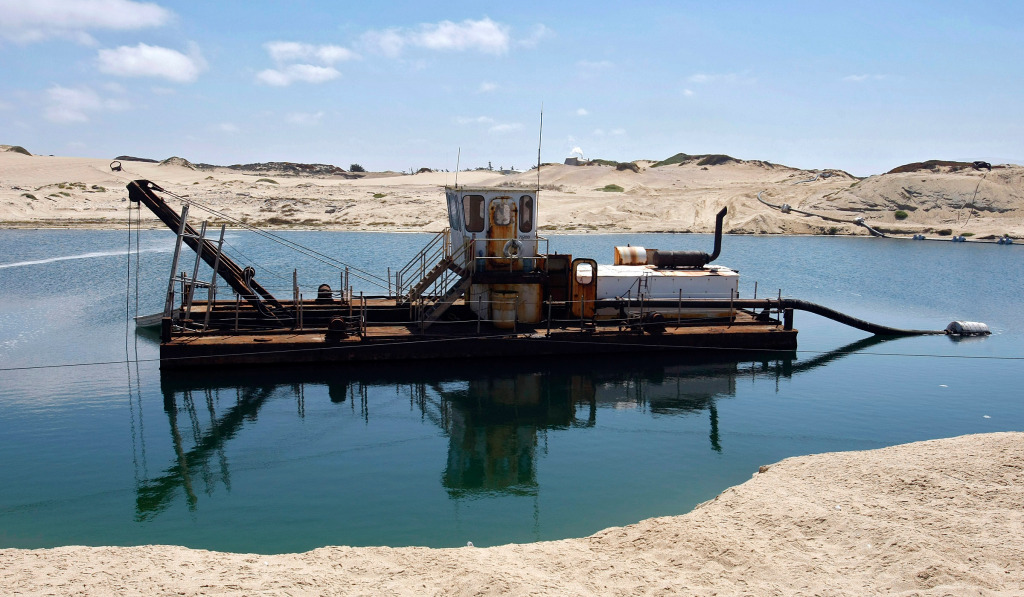MARINA — The sands are shifting on Marina and nearby beaches as the country’s last coastal sand mine nears shut down in Marina.
On Dec. 31, the CEMEX Lapis sand plant in Marina will permanently close, ending over 100 years of sand mining.
Many scientists believe the closure of the sand plant off of Lapis Road will widen the shoreline, as more sand will flow unhindered down the coast. For Marina residents, this may mean more beach to enjoy.
“You definitely would expect that the coast will build out,” predicts Patrick Barnard, a coastal geologist with the United States Geological Survey.

Barnard explains that we are changing the shoreline system “in a very significant way, by quite rapidly adding a significant amount of sand. We expect to see a very large response.”
Since September 2018 the United States Geological Survey has surveyed the shore near the CEMEX sand plant twice. The most recent survey found a greater volume of sand piled up down the coast from the CEMEX plant as the company has slowed its mining activities. CEMEX did not respond to requests for comment on this story.
It’s difficult to tell whether these results are caused by the mine ramping down or some seasonal factor, says Barnard.
Rising sea levels, fluctuations in the amount of sand flowing out of the Salinas River and winter storm activity all make it difficult to predict exactly how the coast will change, says Gary Griggs, professor of earth sciences at UC Santa Cruz. But over the long term, Griggs adds, the coastline’s response to the mine closure should be measurable.
Griggs predicts the mine’s closure will impact only the coast between Del Monte Beach in Monterey and the Salinas River mouth.

“The Monterey Peninsula and Big Sur would be totally unaffected as their sand comes from different sources,” says Griggs.
CEMEX extracts sand directly from a large dredge pond on the beach at the mine site. This pond is refilled by waves that carry sand from the ocean.
Ed Thornton, professor emeritus of oceanography at the Naval Postgraduate School, predicts that with the mine closing, the pond will disappear in one or two years as waves fill it with sand.
Future uses
In 2017 CEMEX reached an agreement with the Coastal Commission to close and reclaim the mine site which has been in operation since 1906. As per the agreement, CEMEX must restore the site to natural conditions by Aug. 17, 2023.
Upon sale, a deed restriction will be placed on the property that provides for public access and conservation.
Marina Mayor Bruce Delgado says the plan is for a nonprofit organization to purchase the site from CEMEX after it reclaims the site. The sale would likely take place in 2023.
According to Delgado, interested buyers include the Big Sur Land Trust and the Monterey Peninsula Regional Park District.

After the sale, a public planning process will decide the layout and construction of a trail system to enable public beach access.
“We want to do what’s best for beach access and leisure and enjoyment while protecting natural resources,” says Delgado.
California American Water has introduced plans to drill slant wells at the site for its desalination project but Marina has denied the company a permit. Cal Am is appealing it with the Coastal Commission.
Coastal erosion
The southern Monterey Bay has the highest coastal erosion rates in the state, averaging about 4 feet per year, and about 6 feet per year near the CEMEX Lapis sand plant, according to Griggs. Scientists and activists have blamed the severe coastal erosion on the mining of sand.

Breaking waves move sand up and down the beach and along the coast, says Griggs. When large amounts of sand are removed the waves reach further inland and erode more of the dunes and shoreline.
“The low bluffs and dunes of southern Monterey Bay are eroding from Del Monte Beach to the Salinas River,” says Griggs.
According to Thornton, the CEMEX Lapis plant was consistently extracting about 250,000 cubic tons of sand each year, or about 25,000 dump trucks of sand per year.
But as per the agreement with the Coastal Commission, CEMEX was ordered to reduce extraction to 134,520 metric tons per year during the three years leading up to closure.
Between 1906 and 1990 southern Monterey Bay was the most intensely mined shoreline in the country. At the peak of sand mining activity, six sand mines were operating in the Monterey Bay region.
Five of these mines were closed in 1989, when they were blamed for high coastal erosion rates, leaving the CEMEX Lapis plant the last mine standing.
One of the mines closed in 1989 was located in Sand City. According to Thornton, before 1989 the Sand City coast was eroding more than 6 feet per year, while at Marina the erosion rate was about a foot per year.
But after Sand City and the other mines closed in 1989, CEMEX began to ramp up production at Marina. As a result, the coast near Marina began eroding more than 6 feet per year, while erosion rates near Sand City dropped to about a foot per year.
All of the mines closed in 1989 extracted sand from the ocean using drag-lines, while the CEMEX Lapis sand plant dredges sand from a pond on the beach.
The sand mine’s closure comes after many years of campaigning by local residents and environmental groups to end sand mining in Monterey Bay.
Victory is especially sweet for Thornton, who first noticed the effects of sand mining on Monterey Bay’s coast in the 70s. For decades he has been a leading voice in the fight to end sand mining in Monterey Bay.
“It’s over, we won,” says Thornton, adding “the ‘we’ means all the people that enjoy our incredible beaches.”










